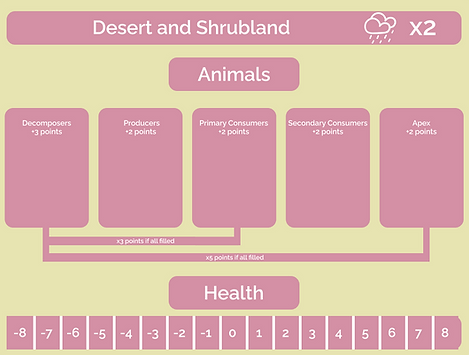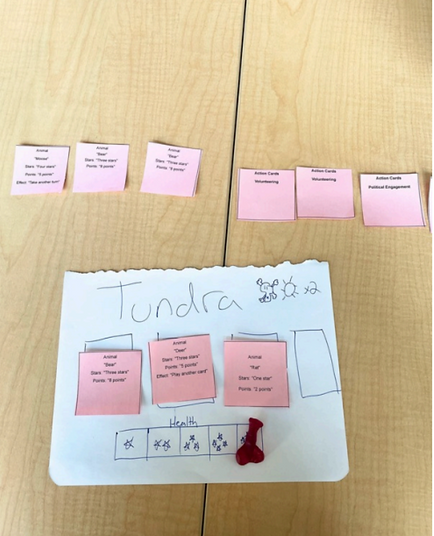Case Study
Terra Nova
Encouraging youth action in local communities

How can we teach systems thinking and environmental interdependence through play?
COMPANY
Self-owned
SKILLS
UX Design
Game Design
Systems Thinking
Instructional Design
Product Management
Playtesting & Iteration
TEAM
Lead Game Designer & Co-founder (Ari Rosenthal)
Lead Product Designer & Co-founder (me)
1 Curriculum Designer
2 Youth Advisors
2 Game Design Advisors
DURATION
Jan 2025 - Present
Problem
Climate change education is often framed through facts, charts, and sobering predictions, but rarely through systems thinking or personal engagement. We saw an opportunity to design a game that would empower middle and high school students to think critically about the relationship between ecosystems, environmental threats, and collective resilience.
Inspired by co-design practices and the Next Generation Science Standards (NGSS), we set out to build a cooperative tabletop game where players take on the role of ecosystems working together to survive global threats like deforestation, pollution, and biodiversity loss.
Solution
We designed Terra Nova, a card-based cooperative game for 3–5 players. Each player adopts an ecosystem (e.g., rainforest, desert, tundra) and must make tradeoffs about which species to sustain, which global events to address, and how to collaborate with others to preserve global biodiversity.
Gameplay is turn-based, with each round introducing new environmental "event cards" and "solution or symptom cards" that force players to adapt strategies in real time. Players use action cards to address threats and animal cards to populate their ecosystems.
Ari created the game mechanics, I developed the game design and interfaces, and we developed systems for:
-
Balancing game difficulty and pacing across four rounds
-
Ensuring replayability and alignment with climate learning objectives
-
Managing asset creation and iterations via weekly meetings and playtesting
The game is intended to be played in informal settings within classrooms and outside the classroom.
This approach ensures students engage not just with climate facts, but with the systems thinking and emotional collaboration needed to tackle real-world environmental challenges.


Most recent version (V5) being play-tested
Impact
Through multiple rounds of play-testing, we saw consistent engagement and collaborative problem-solving. We saw:
-
Improved understanding of environmental interdependence
-
A sense of emotional investment in their ecosystems
-
Conversational appeal about the actions in game and what the play-tester can do in real life
"Wait! This game is actually fun."
Seven year old play-tester
Most recent version (V5) Game Pieces




Player Environment Mats

World Map (relates to mat colors) All Mats Connect to the Sides of the World Map

Round Tracker


Tokens to be Places on Animal Cards if Environment Continues to be too Unhealthy
Play-testing and Personas
We play-tested each version of our game (5 versions thus far) multiple times, changing one to two mechanics per version and incorporating feedback from experts within climate education, civic games, and youth advocacy.

The Emerging Eco-Leader
Background: 6th grade student, enjoys Minecraft and competitive card games
Needs: A sense of progress and clear goals, fun mechanics, and room to express agency
Frustrations: Doesn't like games that feel like school or are too text-heavy
Goals: Hopes to do things that matter to them with their peers

The Time-Strapped Teacher
Role: Middle school science teacher
Needs: A game that fits into a 45-minute class, is easy to set up, and ties into NGSS
Frustrations: Lack of classroom-ready climate education tools that engage students
Goals: Deliver meaningful content through play without needing extensive prep

The Youth Advocate
Age: 14
Background: Interested in social justice, watches climate TikToks, active in school clubs
Needs: Direct connections to action and the ability to share their voice
Frustrations: Too many resources that are “all talk” and not actionable
Goals: Make real-world change and connect with other youth doing the same
Iterated Design
We began with a strong foundation: a game that blended ecosystem-building, action-oriented play, and event-based threats. Our first prototype centered on environmental mats, animal cards, and action cards representing real-world interventions. The early version emphasized competition and civic agency. However, after playtesting and receiving feedback from experts at Sesames Street, we saw opportunities for improvement in clarity, engagement, and instructional alignment.
What We Noticed
During internal and external play-tests, we observed several patterns:
-
Players were confused by the overlap between certain card types (especially Action vs. Event card logic).
-
There were too many abstract mechanics up front, making onboarding slow especially for younger players.
-
Despite rich content, the game leaned too heavily on individual achievement rather than collective resilience.
What Changed
Guided by these insights, we refined the components of the game:
Card Categories
We reorganized action cards into three categories:
-
“Individual” – for individual efforts
-
“Collective” – for community collaboration
-
“Institutional” – for political or systemic change
This change made game play more intuitive while reinforcing real-world civic engagement. We tried making these card more action oriented in earlier versions by stating "I Do" , "We Do", and "Change Making." However, we received feedback that this didn't match the collective game play.
Rebalanced Event Cards
We added variable impact by environment, ensuring that players’ strategic choices mattered while still encouraging collaboration. Initially we had each action impact all environments equally. Now, each event indicates which ecosystems it affects most, modeling climate interdependence.
Improved Game Objectives
We kept point scoring to retain motivation, but shifted emphasis to shared success:
To win, players need the most points.
To beat the game, all ecosystems must survive.
This dual-goal system aligned with our core value of collective climate responsibility.

First game prototype
From Prototype 1 to Version 5: Design Iterations

Version 1 event cards

Version 2 & 3 event cards


Version 4 & 5 event cards
Event Card Iterations

Potential future design of all Event Cards

Version 1 animal cards

Version 2 & 3 animals cards

Version 4 & 5 animal cards
Animal Card Iterations

Potential future design of all animal cards



Version 1 action cards



Version 2 & 3 action cards



Version 4 & 5 action cards
Action Card Iterations
Constraints
Every project faces limitations. Here are the main ones we navigated or are currently navigating:
-
Complexity vs. Simplicity: Our prototypes earlier on hit the right amount of time per game (20 mins), however by implementing recommendations, our most recent version has many rich mechanics but were overwhelming for new players. We are currently balancing the depth of the game.
-
Team Skillsets: We have a strong design and pedagogy team, but limited in-house development capacity for curriculum design and a full digital rollout, requiring phased web development. We have instead focused solely on the card game at this time.
What's Next?
As Terra Nova enters its next phase, our goal is to
-
Live Demo Version: Make a demo version that includes fully designed animal, action, and event cards for larger scale play of our card game.
-
Focus on Online Component: Expand and fully develop the web-based version of the game to deepen real-world relevance, enabling players to seamlessly connect in-game actions to tangible civic engagement opportunities and climate solutions.
-
Printable Access Model: To ensure equity, we’re creating a low-tech printable version of the game for communities with limited access to devices that will be available online.
-
Partnership Development: We’re exploring collaborations with environmental nonprofits, youth-led movements, and educational game publishers to expand reach and support community missions.

Online platform MVP